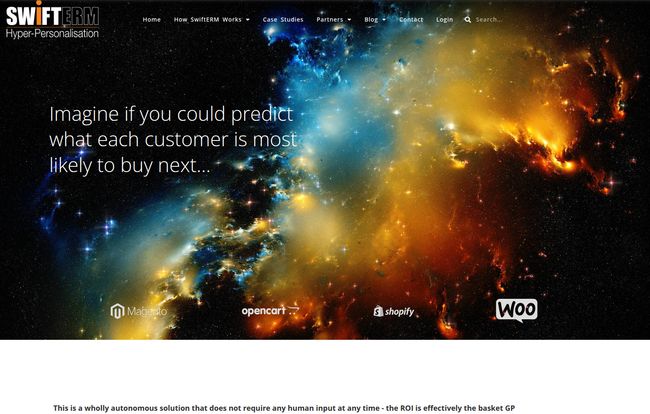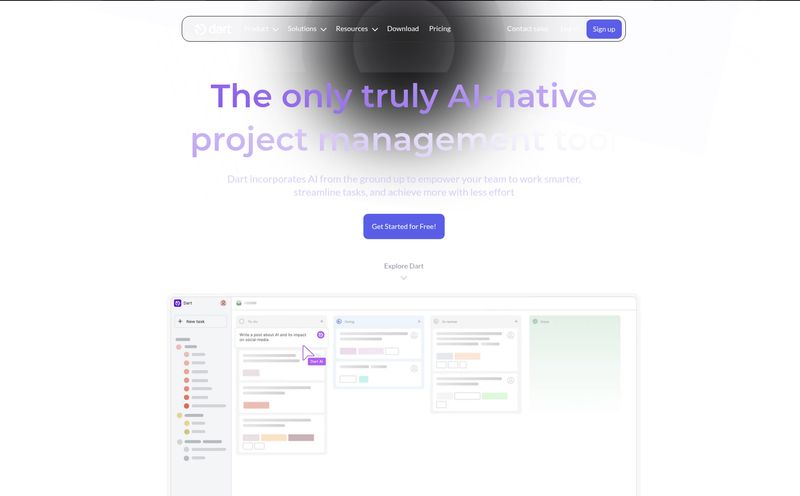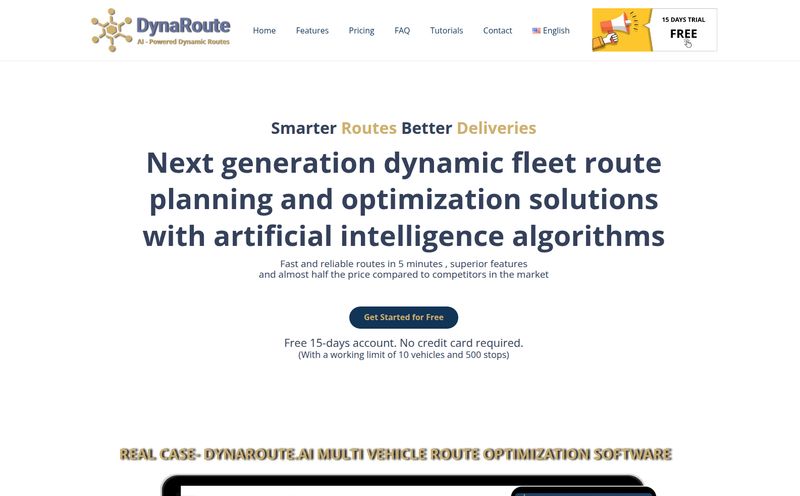I've been in the digital marketing game for years—long enough to remember when 'social media manager' wasn't a real job title and getting a good rank on AltaVista was the pinnacle of SEO. And through all of it, one thing has remained constant: the email marketing grind.
We segment our lists. We A/B test subject lines until our eyes glaze over. We build complex, triggered workflows that look like a madman's flowchart. And for what? To send a coupon for dog food to a cat person because they once bought a chew toy as a gift. It's a system built on educated guesses, and frankly, it can be exhausting.
So when I stumble across a tool that claims to throw all that manual labor out the window, my cynical-old-blogger ears perk up. The tool is called SwiftERM, and it's not just another email platform. It's a fully autonomous, AI-driven system that promises to know what your customers want to buy even before they do. A bold claim. Maybe an impossible one? Let's see.
So What Is SwiftERM, and Why Should You Care?
Imagine having a personal shopper for every single person on your mailing list. Someone who doesn't just know they bought a blue shirt last month, but also knows they lingered on the page for a new pair of jeans, glanced at a leather belt, and that their buying frequency peaks on Tuesday afternoons. Now imagine that personal shopper sending them a perfectly curated email with those exact items at that exact moment.
That's the elevator pitch for SwiftERM. It’s not about batching and blasting. It's AI hyper-personalization software for ecommerce. It hooks into your store, watches everything, and then uses that impression and purchasing data to send unique, one-to-one emails to each customer. The goal isn't just to make a quick sale; it's about nurturing customer lifetime value (CLV) by consistently showing people things they're genuinely interested in. It’s a pretty big departure from the 'one-to-many' approach we’re all so used to.

Visit SwiftERM
The Magic Behind the Curtain: How It Actually Works
Okay, so 'AI' is a buzzword that gets thrown around so much it’s almost lost all meaning. It's the 'synergy' of the 2020s. But in SwiftERM's case, it seems to be a practical application. The process is surprisingly straightforward, at least from the user's perspective.
You start by installing a plugin on your e-commerce platform. I saw logos for Shopify and Magento, so it clearly plays nice with the big guys. Once that plugin is active, it becomes a silent observer, gathering a ton of data points for each shopper: what they click on, how long they view a product, what they add to their cart (and what they abandon), their purchase history, how often they visit—the whole shebang. It's a firehose of behavioral data.
This Isn't Your Average Email Segmentation
This is the part that got my attention. SwiftERM takes all that data and feeds it into its machine learning algorithm. The system then calculates, for each individual consumer, what they are most likely to buy next. It’s predictive. It then sends them an email—not on a schedule you set, but on a schedule the AI determines is the optimal moment of influence for that specific person.
The best part? It's all completely autonomous. Zero staff overhead. No one is sitting there building segments or designing templates. After setup, it just... runs. For a small business owner wearing a dozen hats, or a marketing manager stretched thin, the idea of a revenue-generating channel running on autopilot is more than just appealing; it's a godsend.
The ROI Claims Are Wild, So Let's Talk Money
This is where things get really interesting. SwiftERM doesn't just promise cool tech; it promises cold, hard cash. They boast an average 20x ROI and even have a price guarantee of a 4x ROI. That's a confident stance. If you don't make at least four times what you paid, you get your money back. I've seen a lot of SaaS platforms, and guarantees like that are rare.
The pricing is tiered based on the size of your contact database. It's pretty transparent, which I appreciate. I've pulled some of the key tiers from their site to give you an idea:
| Monthly Cost (GBP) | Database Size | Estimated Monthly Turnover Return |
|---|---|---|
| £100 | 0 – 19,999 | £3,000 – £5,000 |
| £300 | 30,000 – 39,999 | £9,000 – £15,000 |
| £1,000 | 100,000 – 109,999 | £31,000 – £50,000 |
| £10,000 | 1,000,000 – 1,000,999 | £310,000 – £500,000 |
Note: This is a simplified table. Check their official pricing page for full details and USD/EUR options.
Seeing the potential return laid out next to the cost is a powerful sales tactic. It shifts the conversation from "how much does it cost?" to "how much could I be making?" And they offer a 30-day free trial, so you can test the waters without commitment.
My Honest Take: The Good and The Not-So-Good
No tool is perfect, right? After digging in, here's my breakdown. I'm not a paid shill, so I'll give you my genuine perspective.
What I Really Like
The hands-off, autonomous nature is the biggest win for me. The idea of adding an incremental revenue stream that requires literally zero ongoing work is incredible. It supplements what you're already doing with your regular newsletters and campaigns. I also love the focus on CLV. We often get so caught up in immediate conversions that we forget the gold is in repeat business. A tool designed to nurture that loyalty is smart marketing. The ROI guarantee is the cherry on top—it shows they have serious skin in the game.
A Few Things to Keep in Mind
First, it's not magic. It relies on a plugin, so there's a small technical step to get started. If you're completely tech-phobic, that might be a hurdle, though it's likely a simple install. Second, the pricing is based on contact volume. For stores with massive databases, the cost can look intimidating, though the projected ROI is designed to more than cover it. Finally, you have to place a certain amount of trust in the AI. If you're a control freak who needs to approve every single email, a fully autonomous system might give you anxiety. You have to be willing to let the machine do its job.
Frequently Asked Questions About SwiftERM
- Is SwiftERM hard to set up?
- It primarily involves installing a plugin on your e-commerce site. For most major platforms like Shopify, this is a very straightforward process that shouldn't take more than a few minutes. It's designed to be a one-and-done setup.
- Does SwiftERM replace my current email marketing software like Mailchimp or Klaviyo?
- Not necessarily. SwiftERM positions itself as a supplementary tool. You can still send your regular newsletters, brand updates, and sale announcements with your existing provider. SwiftERM runs in the background, sending hyper-personalized product emails to individuals, adding an extra layer of revenue.
- Is the AI really 100% autonomous?
- Yes, that's its main selling point. Once configured, you don't need to manage it. There's no A/B testing, list management, or campaign creation. It handles the who, what, and when of email sends on its own.
- How does the 4x ROI price guarantee actually work?
- Based on their site, if the system doesn't generate at least four times its monthly cost in revenue for you, you're entitled to a refund for that period. It's a way to de-risk the investment for new customers. I'd recomend checking the fine print on their site for the exact terms, of course.
- Is SwiftERM a good fit for a small but growing e-commerce store?
- I think so. The entry-level pricing at £100/month for up to 20,000 contacts is accessible. Given the potential turnover of £3,000-£5,000 at that level, it could be a massive boost for a small business without adding to the workload. The free trial makes it a no-brainer to at least test.
The Final Verdict: Is It Time to Let the Robots Take the Wheel?
Look, I came into this with a healthy dose of skepticism. But I'm walking away genuinely intrigued. SwiftERM isn't trying to be another jack-of-all-trades email platform. It does one thing—automated, predictive, personalized product emails—and it seems to do it exceptionally well.
If you're tired of the email grind and the law of diminishing returns from your generic campaigns, it's definitely worth a look. The idea of bolting on a revenue-generating machine that thinks for itself is the kind of efficiency we've been promised for years. Maybe, just maybe, the future of email marketing is finally here. And it's a lot more relaxed than I thought it would be.



